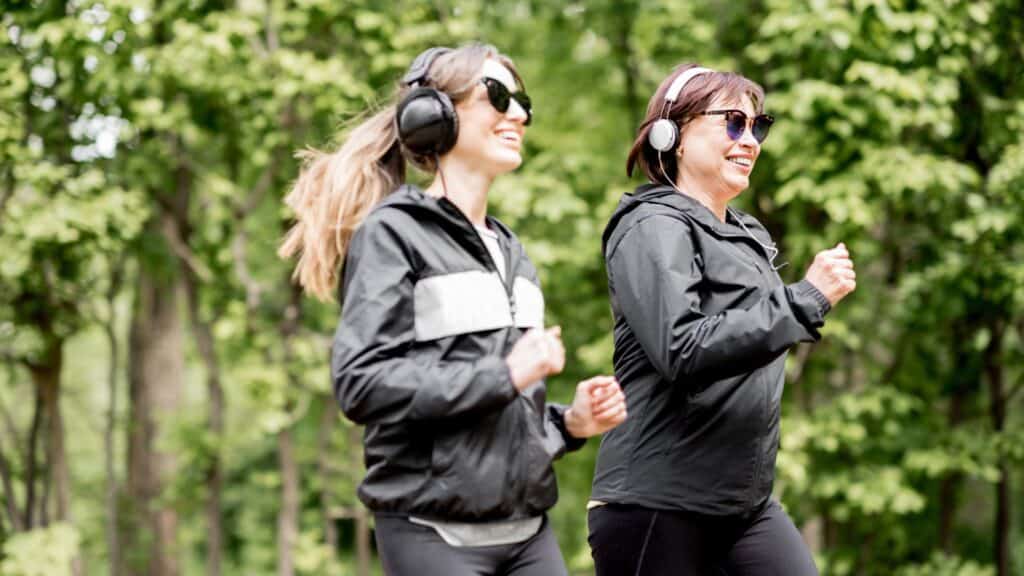If you’ve been sitting on the couch watching so many reruns of Friends that you already know the jokes before they’ve been delivered and you’re looking for an excuse to get moving, then Parkrun is for you. It’s really easy to get started. There is guaranteed to be one in a park or field close to you every Saturday, rain or shine, all you need is a pair of running shoes and a plan. Best of all, it’s free!
Preparing for your first Parkrun requires the right training plan and a clean bill of health. So before you get started, book a visit to your local healthcare provider, pharmacist, or nurse and make sure you are in good health and have no underlying health conditions that will put you at risk. Once you have the all-clear, look for the training plan that is right for you.
An entry-level plan will get you from sitting on the couch to crossing the finish line at your first Parkrun in no time. Remember to start slow and look for a plan that starts from a beginner’s level of fitness.

Where Did Parkrun Start?
Parkrun was started in 2004 by 13 novice runners. It’s a standard 5-kilometer or 3.1-mile route. Don’t let the distance scare you, it’s perfectly manageable for a beginner. And remember there’s no shame in following a run/walk routine, it’s actually recommended.
It’s such a simple idea that Parkrun has spread all around the world and currently takes place every Saturday in over 2,000 locations and 22 countries worldwide. The concept is still in its infancy in the US, so have a look online for your nearest location. If you can’t find one, get some friends together and consider starting one.
For a complete list of locations, see parkrun.com/events or open your web browser and search ‘Parkrun near me’ or visit https://www.parkrun.com/
Parkrun Is For Everyone
Parkrun is accessible to anyone and everyone. You don’t need to qualify or belong to a running club to participate. If you thought you couldn’t run because you have children, then Parkrun is for you – you can bring them along. If you can’t run 5km, Parkrun is for you – you can walk it. Got dogs? Parkrun is for them too! No need to RSVP or book your spot, simply show up with the right attitude and a little bit of enthusiasm. And did I mention it’s completely free?
Parkrun – take your mark.
Get ready.
Set.
Go!
Take Your Mark – Training For Your First Parkrun
Now that you know how easy it is to join Parkrun, achieving your goal of completing your first one starts before you even lace up your running shoes.
Start with a plan! A basic, beginner’s running plan will consist of training 3 days a week. These sessions will consist of a run/walk strategy 2 days a week for 20 to 30 minutes a session. Shona, from Coach Parry, likes her beginner runners (yes, if you’ve put running shoes on and are putting one foot in front of the other, then you’re classified as a runner!) to start with 4 min walking/1 minute running.
Repeat 3-4 times totaling around 15-20 mins for the first week. The goal is not to sprint in that 1 minute. Gradually extend your running time and shorten your walking time each week. For example: in week 2 you would then walk for 3 minutes and run for 2 minutes, again not trying to go as fast as you can when you run. On the 3rd day your total run/walk time should be longer, aim for 30 to 60 minutes. A good idea is to start with 30 minutes and build up weekly by adding 5 minutes.
You should aim for a pace that enables you to hold a conversation while running. It’s always nice to have someone to chat with so take a friend along. You can train for your first Parkrun together. You should be able to hold a conversation with your friend, or yourself (if like me you talk to yourself), and not get out of breath! If you’re out of breath – you’re going too fast.
Strength training is another important part of your training plan.
This is what’s going to help you stay injury-free and keep you on the road/trail.
I recommend starting out with 1 strength session per week. Find a strength plan that is running-specific and focuses on core, and lower leg stabilizers as well as glutes, hamstrings, and quadriceps.
If you’re brand new to running this is going to be vital to your success, so be consistent. Remember, strength training doesn’t need to be all weights and machines, start with bodyweight training for 20-30 minutes and build up from there.
Exercises like toe raise and forward & lateral band walks, for example, are perfect. Our free strength training plan is a great place to start and you can download it by clicking here.
Rest and cross-train on your days off. It’s important that you have at least 1 full day of rest per week. Rest helps your body to recover. And recovery is actually where you get the benefit of all the running you’ve been doing. Cross-training can include swimming and cycling.
If you are looking for a more structured plan, We have the perfect one to get you through your first Park Run.
We have a team of experts who work together to give you the best advice to get you across the finish line. We also have easy-to-follow YouTube videos and plenty of friendly advice to help guide you through.
With expert advice completing your first Parkrun is going to be a walk – or run – in the park.

Get Ready
Get yourself a good pair of running shoes. They don’t need to cost a fortune, but they do need to be comfortable and provide good support while you run. Ask a knowledgeable salesperson for some guidance on your first pair. Take some socks with you so you can run up and down the sales floor and test a few shoes. Your feet expand while running so make sure they’re not too tight. It’s a good idea to get one size up from your usual shoe size. This allows your foot to move and not damage your nail bed and toes.
A special note for the ladies, a good sports bra will not only keep you comfortable while enjoying your Parkrun but will also take care of your breast health. Look for a high-impact bra; these are usually designed for high-intensity workouts like running.
Your sport’s bra size is usually the same as your regular bra size, don’t be tempted to size down for more support. Your cup size may vary though, try a few to see how they fit. Cups should fit snugly without gaps or wrinkles but not so tightly that your breasts ‘spill out’ at the top or sides. Ideally, you should look for a bra that is adjustable on the straps and the chest. Pull-over compression bras don’t offer much support especially if you’re big-breasted.
Some additional notes for the ladies:
These handy tips will help you pick the right fit to get you ready for your first Parkrun.
- Your sports bra should be snug, but not so tight that it restricts your breathing. You should be able to fit 2 fingers between the straps and your shoulders.
- Wrinkles are bad, especially on your sports bra. The cup fabric should be smooth, wrinkles mean that the cup is too big.
- The underwire should lie flat against your ribcage below your breast tissue and should not pinch or dig in.
- Raise your arms above your head. Adjust the straps or back closure if the band rides up when you raise your hands.
- Jump around and wave your arms – if you feel uncomfortable or it’s too tight – try another size.
Now that you have your bra and shoes, you’ll also need a good sun hat or peak, sunscreen (the higher SPF the better) moisture-wicking clothing, and a water bottle. It’s just about time to head out the door. But before you do, it’s best to do a little research.
Choose a Parkrun that’s closest to you. You may be surprised to find a few in your area all offering the standard 5km or 3.1 mile Parkrun distance.
To find one that’s closest to you click here: https://www.parkrun.com/countries/ choose your country and then your closest location and you’re almost set to go.
You can also search Facebook as most Parkruns have their own pages that include the exact location of the start.
Speaking of Facebook, why not join our Facebook community: The Runner’s Club – Motivation & Training
You may want to look-up reviews on your chosen run to help you decide which is best for you. Perhaps you want a flat-ish route to start with or maybe you’re just looking for a Parkrun with a country feel so you can enjoy the scenery?
Doing your research will help you find the right one. You’ll probably end up making a list of all the different ones you would like to try in the future.
Remember there is also a link to register and print your barcode. You may want to print a few copies to keep in your car or gym bag so it’s easily accessible for Parkrun Saturday. You can still run if you don’t have a barcode, but unfortunately, you won’t receive an official finish time.
You also won’t be able to accumulate your documented finishes towards your Parkrun milestones, so you won’t receive the commemorative T-shirts. The barcode is also linked to your emergency contact information so it’s better to register and have one, so you can start recording your runs and get help if you need it.

Another tip to help you get ready is to check the local weather app.
The weatherman only has a 50/50 chance of getting it right, but he can give you a good indication of what to expect on Parkrun day. If it’s going to be cold, dress in layers to keep you warm at the start but you can easily peel off as you warm up. If it’s going to be hot and sunny, remember to apply a good SPF and take a peak cap to run in. You might also want to take a water bottle along to keep hydrated or to refuel afterward.
Get Set!
How Early Should I Get to Parkrun?
You’ve been following your training plan, you’ve chosen your first Parkrun location, you’re dressed for the weather and your barcode is printed, grab your bottle of water and you’re all set to go.
Get to your chosen Parkrun about 15 to 30 minutes early. This gives you various advantages like checking where the start and finish line are or chatting to one of the volunteers if you have any questions. You will also be in time for the pre-run briefing. This is where the volunteers point out any potential bottlenecks, hazards, or mud puddles along the run. They will also give a brief outline of the route.
Going early also gives you a bit of time for a pre-run warm-up.
Dynamic stretching: toe-touches, squats, or lunges all help to prepare your body. Most importantly, arriving early allows you to check out the best place for a post-run coffee – post-run recovery is also important!
… And Go!
What To Do At The Start Of Parkrun
You’ve done all the legwork, and now it’s Go Time! Before the volunteers count you down and you start running, take some deep breaths and remember your goals. Don’t get too caught up in the moment and try to get to the finish line as fast as you can, you’ll end up hurting yourself. Remember your goal is to cross the finish line.
Take it one step at a time. Remember, we recommend using a run/walk strategy, even if your walks are only 20-30 seconds every kilometer.
In fact, a run/walk strategy is one of the best ways to keep yourself moving forward! To keep motivated, break the race into bite-sized chunks. Celebrate when you reach halfway, and tell yourself you are almost there!
Keep The Momentum Going – Achieve Your Parkrun PB
Well done! You’ve finished your first Parkrun! Once you’ve completed your first one, it’s easy to keep going! Come back to the same Parkrun every week and revise your goals. Or try to find a new Parkrun whenever you visit a new city! It’s a great way to explore a new place. Work on achieving your PB (Personal Best) or set your sights on improving your finish time.
To help you achieve your PB goals:
- Choose a fast course! With no hills to slow you down, a flatter course will allow you to run faster.
- Establish a good rhythm from the beginning by positioning yourself close to the start, but not right at the front. You won’t break your rhythm by having to move through slower walkers and joggers at the back.
- Add some speedwork to your training once you’ve built up your aerobic engine. But don’t jump into speed work too soon, you’ll risk getting injured. Speak with the team at Coach Parry to help you revise your plan to reach your new goals.
- Warm up properly. Your body needs to prepare for exercise in order to perform optimally. A warm-up could include a jog to the start if you live close by and some dynamic stretching as suggested.
- Fuel up with some simple carbs like peanut butter on toast and a banana for breakfast before your run to ensure your energy levels are up.
- Knowing the course, where the sharp turns, ditches, and finish line is can shave some valuable seconds off your run.
- Remember your barcode! You won’t be able to claim your official Parkrun PB unless it’s recorded.
How To Beat Your Parkrun PB: A Comprehensive Tutorial
The Benefits Of Parkrun
Apart from improving your overall well-being an added bonus to Parkrun is seeing the same people every Saturday and getting the chance to make new friends. This could really help you feel at home if you have just moved to a new area. You can also explore new places by trying out different Parkruns or finding local ones to try out when you go on vacation.
You can even take on Parkrun challenges like the Snake, Alphabet, or Pirate challenge. Have a look here to get some ideas: https://www.ianruns.com/p/challenges.html make up your own and challenge your friends.
Giving Back
If you get injured or need to take a break from running, you can still take part in Parkrun and give back to your community by volunteering. Parkrun relies on volunteers to keep it going week after week. This will keep you in touch with your new running friends and you’ll feel motivated to return as soon as you can.
The world is your oyster – and it all begins with a run in a Parkrun.



Comments are closed.